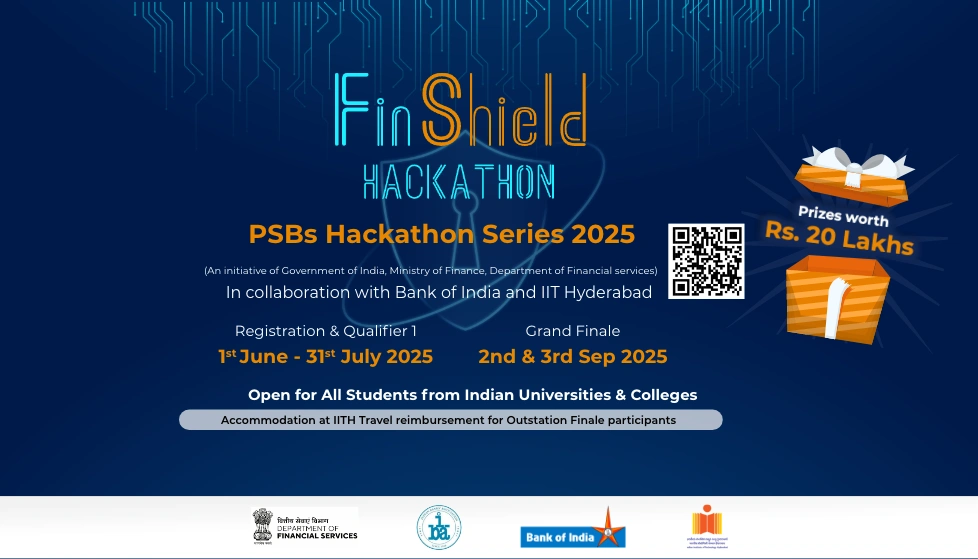cybersecurity-hackathon
PSB’s FinTech Cybersecurity Hackathon 2025 In Collaboration with IIT Hyderabad
Bank of India (BOI )is proud to host PSB’s FinTech & Cybersecurity Hackathon 2025, in collaboration with IIT Hyderabad & IDRBT . This initiative is powered by the Department of Financial Services (DFS ) Ministry of Finance / Indian Bank Association (IBA) aims to foster collaboration between public sector banks, educational institutes and students and to promote innovation, prototype development, and entrepreneurship in the banking sector.
About the Hackathon :
PSB`s FinTech & Cybersecurity Hackathon is a national-level initiative powered by the Department of Financial Services (DFS) Ministry of Finance/Indian Bank Association (IBA) . This hackathon provides a platform for students, banks, and educational institutes to collaborate and create innovative solutions for the financial sector that can solve real-world FinTech & cybersecurity challenges.
Selected teams will work on problem statements, and the event will culminate in September 2025 with the presentation of winning prototypes showcasing their potential for real-world implementation.
Why You Should Participate :
The one of its kind Hackathon , which is an initiative of Ministry of Finance, Department of Financial Services & coordinated by Indian Banks Association (IBA)
Exciting Prizes: Win rewards worth up to Rs 20 Lakhs.
There are two topics for better participation , Prize Pool of Rs. 20 Lakh (Rs. 10 Lakh for each topic) -
- 1st Prize - 5 Lakh
- 2nd Prize - 3 Lakh
- 3rd Prize - 2 Lakh
cybersecurity-hackathon
Eligibility :
This hackathon is open for all students from any institutes/universities.
Registration of Participants & Teams (Each team will consist of 3-4 students & as part of Women Empowerment, preferably 1 or more female participants should participate from each team).
Problem Statement:
- Develop Credit Risk Management Model using alternative data to arrive at probability of default search and tracking of defaulter
- Impersonated Registration/Frauds in Mobile & Internet Banking along with behavior based user authentication with password less login
For more information , Kindly refer below table.
| Problem Statement | Description | Desired Outcome |
|---|---|---|
Develop Credit Risk Management Model using alternative data to arrive at probability of default search and tracking of defaulter |
This leads to a large part of the population in most emerging markets failing to access banking channels and consequently remain unbanked or underbanked, effectively denying lenders a gauge of their creditworthiness. Traditional thinking basis for traditional credit scoring models depends on historical financial data like credit reports and bank statements to exclude persons and small-sized businesses with limited financial track records. Fintech companies are starting to use alternative sources of information, such as social media activity, mobile phone usage, and utility payments, to determine the credit risk far more accurately than traditional methods. Traditional credit scoring models are inadequate for assessing the creditworthiness of individuals and businesses without extensive credit histories. |
The desired output is a new credit risk model that uses alternative data sources to improve the accuracy and representation of credit assessments. It needs to be transparent, scalable, and comply with data privacy regulations for it to allow lenders to extend credit to under-credited populations with minimal risks involved. |
Impersonated Registration/Frauds in Mobile & Internet Banking along with behaviour-based user authentication with password less login |
Registrations by fraudsters, impersonated as customer, in mobile & internet banking applications is a major security concern. Fraudsters impersonate as bank, courier, customs or police officials and send dubious link to customer to install apps. Then initiate mobile banking registration on fraudster’s device and obtain OTP, debit card details or other authentication details from customers. After successful registration they transfer funds to fraudster’s account.
|
Participants are expected to provide solution to banks to differentiate between actual customer Vs fraudster initiated mobile/internet banking registration.
Solution must provide option to traditional authentication factors which are now getting exploited by fraudsters to enable password less login. |
cybersecurity-hackathon
How to Register:
Interested students can register through the following link: https://finshield.iith.ac.in/hackathon
Don’t miss this unique chance to collaborate . Let’s gear up for this exciting journey and make it a remarkable experience!
For more reference:
Event Timeline: June 2025 – September 2025
| Task Details | Timeline |
|---|---|
| Registration of Participants & Teams | 01st June 2025 to 31st July 2025 |
| Idea submission by the registered teams | 01st June 2025 to 31st July 2025 |
| Shortlisting of Teams based on Submitted Idea | Shortlisted Candidates will be informed through mail |
| Final Shortlisted Teams announcement | 30th June 2025 |
| Start of Phase 2 (Prototype Development) | On receipt of email about shortlisting |
| Periodic Report Submission | 15th August 2025 |
| Final presentation of prototype | 2nd & 3rd September 2025 |
| Prize Announcement and Closure | 3rd September |

